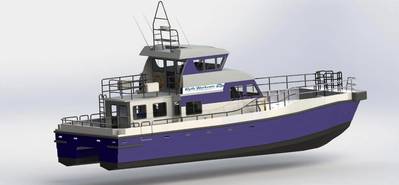New Design for 17 Meter Blyth Workcat
UK boat builder Blyth Workcats has extended its model range with a new design for the recently launched 17-mworkboat.
By relocating the wheel house onto a second upper deck, the company is expecting that the 17-mHigh Bridge will be recognized as a practical and economical option for wind farm support vessel operators.
The first 17-mboat from Blyth Workcats was launched in May and since then it has been praised by its owners Wildcat Marine for its practical design and economical running costs. The new High Bridge design now offers all of the cost benefits of the original version combined with additional cabin space and improved forward visibility for both the crew and the passengers.
The Blyth 17-meter Workcat is the largest boat to come from this long-established Essex, UK, boatyard. It has been designed to provide the offshore energy sector with a practical and robust work boat capable of providing dependable day-to-day transport. It is powered by two MAN D2848, 750hp engines which have been shown to operate at a frugal 130 liters per hour per engine at maximum speed of 26+ knots and just 79 liters per hour at cruising speed of 20 knots.
The low operating costs combined with its spacious accommodation are also expected to make the new Blyth High Bridge 17-meter attractive for tourism and ferry passenger-carrying applications as the company also has designs for a version of the same model with a capacity for over 100 internally seated passengers.
The performance of the Blyth 17-meter is attributed to the balance of fine hull entry and carefully designed chines. These create a hull that performs well at all speeds and sea conditions yet remains capable of providing optimum fuel economy while carrying substantial loads.
The new Blyth 17-meter High Bridge joins a range consisting of 10, 11, 12 and 14-meter catamarans that are built for wind farm support, surveying, dive support, passenger ferry, fishing charter or any of a wide range of workboat tasks. All are built from GRP to offer important advantages over metal hulled boats such as lower running costs and a much lower initial outlay on buying the vessels. GRP boats can also be built to provide strength where it is needed and valuable weight savings wherever the design permits it. Hull lamination and construction is governed by meticulous quality control so the customer can benefit from a boat that has been built to exactly meet their needs while enabling rugged strength and reinforcement to be applied wherever it is needed.











